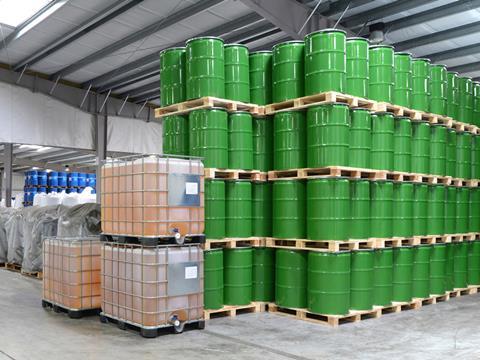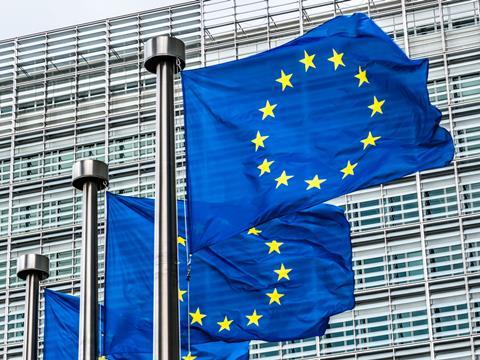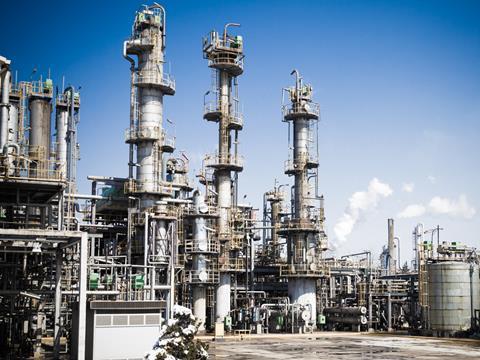Chemicals are a critical, but often overlooked, factor of success for a circular economy. 96% of all products on European markets, from food to medical treatments, from buildings to consumer electronics, rely on chemicals, so this shouldn’t come as a surprise.
Michael Laermann, a sustainability consultant, freelance editor, and founder of Reason & Rhyme in Brussels, looks at what circularity means for the future of the chemicals industry.
The stakes are big. According to the UN “Global Chemicals Outlook” (2019), chemicals sales more than doubled between 2004 and 2014, and are geared towards doubling again by 2030 and potentially quadrupling by 2060. As for Europe, its 28,000 chemical companies with 1.2 million employees added a record €565 billion of value to the European economy in 2018 alone, making it the fourth largest industry in the EU.
With 90% of GDP growth taking place outside Europe in the coming decades, the challenge for the chemicals industry will be to find its place in this growing global market. Can it achieve this better by continuing its transformation into a sustainable industry that supplies other sustainable industries, or should it rather focus on price competitiveness and pushing for more lax regulation?
Europe has recognized that its future competitive edge will be based on resource efficiency and high-quality durable products, so increasing the production of more sustainable chemicals seems the obvious way to go.
The COVID-19 crisis has only highlighted Europe’s need to reinforce strategic autonomy, public health, and environmental standards. But the European market is also seen by many leading companies as the testing ground for what will happen in other global regions in future decades.
The trouble with hazardous substances
21,515 chemical substances were registered with the European Chemicals Agency (ECHA) by 2018, and more and more of these substances are classified as being “hazardous” under the EU’s Classification, Labelling and Packaging (CLP) regulation system.
That means that some 60% of the chemicals circulating on the European market (by weight) have been identified as hazardous for human health and the environment, including basic chemicals like oxygen or hydrogen, that are needed to produce other chemicals, and household products, from detergents and disinfectants to vinegar.

When it comes to implementing the European “Green Deal”, there is a high degree of consensus that for a circular economy to function, the elimination of highly hazardous chemicals in materials flows is key. “It’s all about circularity of chemicals and chemicals’ recycling,” stresses Bjorn Hansen, executive director of the European Chemicals Agency ECHA. “We need to be able to define what is a sustainable chemical and keep that definition stable so that investments can be made to reach chemicals of that nature over the next decades.”
As products are recycled, toxic contents such as endocrine disruptors or PFAS (per- and polyfluorinated alkyl substances) are often recycled with them, becoming “legacy” substances. Yet, up to 70% of the molecules produced by the European chemical industry could be circulated without problem, provided the homogeneity and cleanliness of recycling inputs can be ensured, according to an ambitious scenario outlined by Accenture.
A regulatory road with potholes
European regulation is a global trailblazer, but even this is outdated and inconsistent: Back in the day, EU waste regulation was not developed with a view to implementing a circular economy, preventing waste or decontaminating waste streams. The EU might have the world’s most advanced chemicals regulation, but its rules on which wastes and chemicals are hazardous aren’t fully aligned, and are often even contradictory.
The same material, containing a toxic substance, may be considered either hazardous or harmless, depending on whether it is in waste or a product. So, products made from non-hazardous waste are not necessarily clean and free from harmful substances. The phthalate DEHP, for example, widely used as a softener in plastic products like bathroom products or toys, is a known endocrine disruptor that can damage the human liver, kidneys, lungs, and reproductive system.
Hence, it has been classified a “substance of very high concern” (SVHC) by the ECHA since 2008. But the moment a consumer product with DEHP goes for recycling, it is considered non-hazardous waste and may be recycled into new plastic products, even though the DEHP was not removed. The inherent hazardous substances are therefore often unknown, especially in plastics.
There still is no clear definition of “substances of concern” (SoC), let alone legal requirements to indicate their presence in products. Nor are there policies to ensure traceability throughout the service-life of products until they enter the waste stage.
The EU’s REACH Regulation, for example, only requires basic supply chain communication, such as the name of the harmful substance contained in a product. This obligation does not apply to waste operators. Information in the new SCIP database, currently being built by ECHA for waste operators and consumers, will be limited to SVHC in articles that are placed on the market after 5 January 2021.
Furthermore, there is no agreed methodology to determine the overall costs and benefits to society of using recycled materials containing such substances compared to their disposal.
Finally, there is a persistent lack of compliance and enforcement of EU and national regulation on harmful substances in products, including imports to the E.U., which is why ECHA’s work programme up to 2023 is prioritizing imports and customs cooperation.

A new EU chemicals strategy
On October 14, for the first time in 20 years, the European Commission will present a comprehensive review of its chemicals policy, leading to amendments and new legislative initiatives. The “Chemicals Strategy for Sustainability” is a key component of the “Green Deal”, the EU’s Industrial strategy, and the “Zero Pollution Action Plan” expected in 2021. The Green Deal set the scene by announcing that the new strategy aims at nothing less than “zero pollution and a toxic-free environment”. This is a step change, moving the emphasis from controlling chemicals once they are on the market to preventing toxic chemicals from being included in products at the design stage.
The question persists: Should we keep recycling articles along with their toxic substances? Or is it better to extract and destroy these legacy chemicals in order to purify the material loops? In this policy crucible, some say that the real-life recycling crucibles should be decontaminated by removing hazardous substances from material cycles to ensure a non-toxic environment. Other argue that it is more important to push for higher recycling volumes.
European Commission Director Kęstutis Sadauskas, who is leading the development of the strategy, explains that it will aim at a progressive substitution, classification, and management of hazardous materials to create clean recycling streams: “A circular economy and the Chemicals Strategy are closely interlinked, as it seems clear that the path to safer and cleaner material cycles is promoting substitution of substances of concern and avoiding their introduction in new products, whenever possible.
In the short and medium term, and particularly to address the case of legacy substances that are already present in waste streams; this transition has to be managed.” Making this happen implies a coherent and integrated regulatory framework between chemicals, product, and waste legislation. “When considering possible chemical restrictions, and exemptions to restrictions, we must give more attention to their impact on future recycling and reuse,” says Sadauskas.
“In the second Circular Economy Action Plan (CEAP), the Commission has already committed to implement certain actions to improve this interaction, particularly with regard to the progressive tracking and minimization of substances of concern in product supply chains and ultimately in waste and recycled materials.”
The substitution challenge: Alternatives out of Reach?
While Commission chemicals policy is based on the principles of transparency, prevention and substitution, there are big challenges to put them into action. According to the not-for-profit organization ChemSec, European chemical companies are already beating their American and Asian competitors when it comes to phasing out hazardous chemicals and moving production toward safer, greener alternatives.
The main drivers for these substitution efforts, and the adoption of corporate sustainability policies, are regulatory actions under the EU’s chemicals framework REACH, increased customer demand, and the need to protect brands and public image.
Whilst there are excellent examples of substitution non-essential chemicals, such as the replacement of titanium dioxide as a food whitener with natural rice starch, or fluorinated persistent chemicals with non-fluorinated durable water repellents in clothing, substitution processes tend to be complex.
This is not only due to the diversity of the chemical sector and the complexity of global supply chains. Substitution efforts inspired by the “sustainable-by-design” concept often face difficulties in developing technically feasible alternatives with equivalent performance properties in a competitive environment.
According to the European Chemical Industry Council (Cefic), REACH already has everything needed to drive substitution. Sylvie Lemoine, Executive Director for Product Stewardship suggests the focus should be more on the implementation and enforcement of existing regulation: “There is no ‘silver bullet’ solution to this problem.
There are many complimentary technologies and approaches to remove or separate, where possible, hazardous chemicals from material streams to facilitate recycling.” According to Lemoine, “a sustainable-by-design approach and life-cycle assessment are among the most feasible options to assess the benefits and risks of every substance from the start and consider alternatives, where possible.”

The transparency challenge: “You can’t replace what you can’t measure”
To manage waste, you have to know what’s in it. On this all stakeholders agree. The controversy is in the scope. Which chemicals should be tracked and traced? Should only substances of very high concern (SVHC) be itemized on the ECHA “candidate list”? Or should it include all SVHC? Some interest groups like the European Environmental Bureau (EEB), a Brussels based NGO, follow a preventive approach, demanding that all chemical substances should be traced, in case some might become of a concern in the future.
While the new chemicals strategy isn’t expected to be very specific on this question, Sadauskas supports the idea of progressive tracking: “Improved digital solutions for tracking and managing information on substances of concern in supply chains have an essential role to play in achieving upstream substitution of chemicals.
A feasibility study on the flow of information from the supply chain to waste operators will soon be published, contributing to the ongoing discussions on how to best inform waste operators on the presence of chemicals of concern in products. “
A more progressive faction within Cefic envisions the use of blockchain technology and digital product passports to share information on chemical composition and identifiers of recyclability and degradability for all chemical products via a joint database like the “National Materials DataHub” planned in the U.K.
But a 2019 E.U. research project shows that the willingness of stakeholders to share data about substances of concern along supply chains is likely to be an obstacle. Even for substances that are well studied and REACH registered, data gaps exist that considerably limit the understanding of mass flows in Europe.
The purification challenge: Breaking the legacy of “take-make-waste”
Apart from substitution and transparency challenges, the biggest elephant in the room is legacy substances and the question of how to get them out of the system. Today for example, when it comes to mixed plastic waste containing substances of concern, separate collection doesn’t happen, and decontamination technologies which can be operated at reasonable costs do not exist.
Tatiana Santos, policy manager at the EEB, states that in many cases purification by separation “would be technically possible, provided hazardous substances in products and processes have been avoided right at the design stage. In most cases, however, it is not economically feasible, except for metals”.
So, is chemical recycling the solution? These are processes that turn polymers back into simpler molecules and can purify contaminated substances, as demonstrated at several pilot plants currently in operation. While some stakeholders like Cefic see chemical recycling as a “key technology to potentially separate legacy chemicals and substances of very high concern”, Sadauskas remains cautious: “Chemical recycling is a promising technology.
However, some challenges remain, including the need for more information on the overall environmental performance of these technologies, in particular regarding energy consumption and nature and safety of the process output.” According to the EU official, “a life-cycle approach needs to be followed in order to consider all the possible benefits and risks of these new systems, including on climate. Finally, the results of ongoing pilot projects still need to be expanded to have a representative picture of the possibilities of this technology.”
Who picks up the bill?
For the chemical industry, making the transformation to circular economy has its challenges. Apart from the ones already outlined above, it would require huge investments in infrastructure across Europe—not only in the chemical industry itself, but in other material and energy intensive industries as well. According to an estimation by Accenture, if 20% of the European chemical industry’s capital spending were to be channeled into circular economy projects, it would take 35 to 60 years to build the assets needed for molecule circulation.
In this scenario, if chemical recycling proved to be the only way to technically solve the legacy issue, would it be viable as an intermediate solution, even at a loss, until the day its mission is accomplished? Or would such capital investments lock-in this technology for good, thereby driving the demand for, and the acceptance and generation of, mixed wastes?
On the road to circularity, where would the liability to invest in new assets, processes and products leave the other industries, let alone small and medium-sized enterprises (SMEs)? Could the transformation be catalyzed through extended producer responsibility (EPR) and advanced eco-modulation schemes taking into account externalities such as health and environmental costs?
It remains to be seen what solutions the Commission will forge by throwing these issues into the crucible. Many will be looking to the new Chemicals Strategy for Sustainability to provide the answers. It cannot provide all of them, but it will be fundamental in setting the orientation for a more circular economy, in balancing the trade-offs, and in providing some degree of regulatory certainty for investors.












